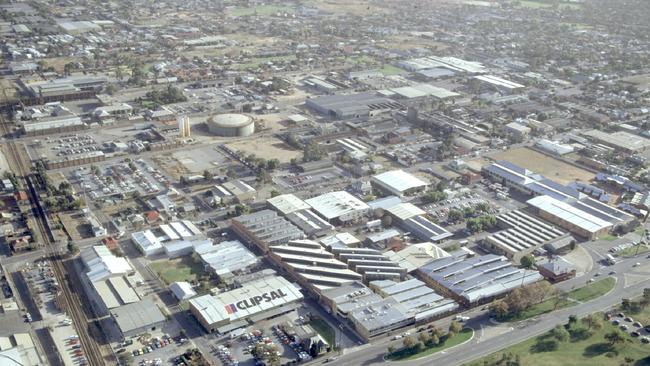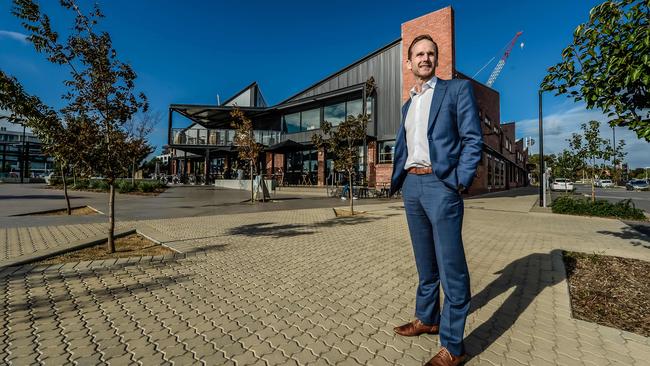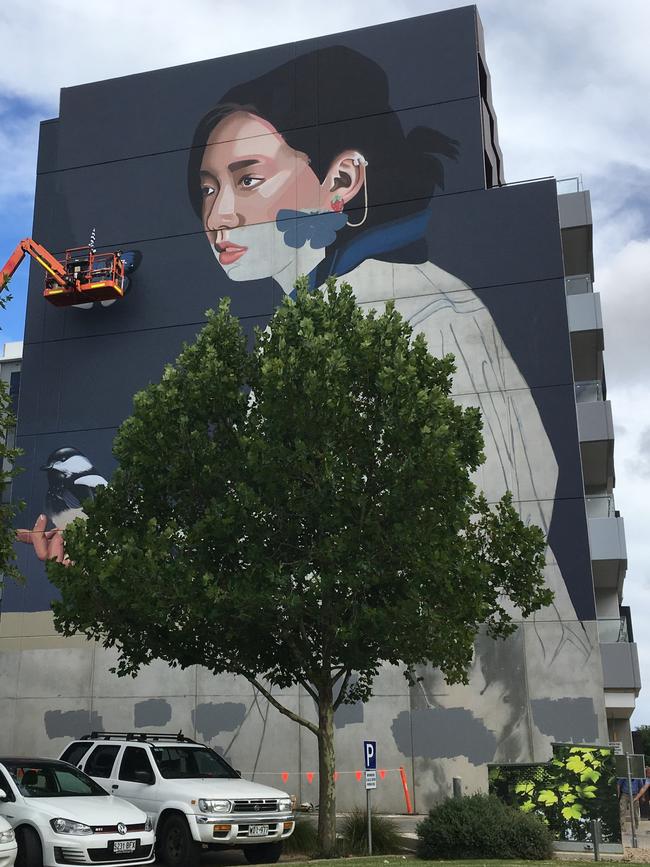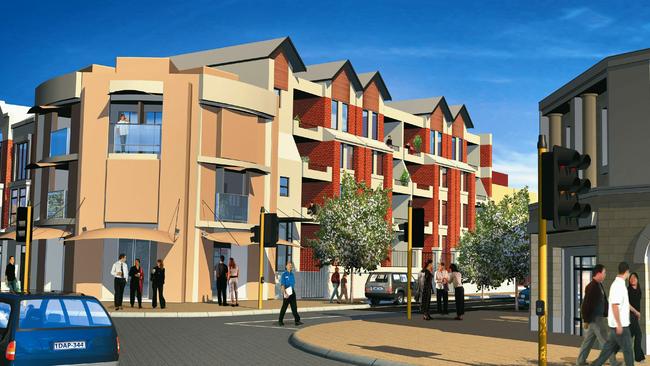Bowden: The suburb at the centre of industrial-sized fight between old and new
IN five years, the Clipsal electrical factory in Bowden transformed from grimy industrial site to a buzzing high-rise estate. But as the 1000th resident prepares to move in, sections of the community fear the suburb’s character is being lost in a ‘concrete jungle’.
City
Don't miss out on the headlines from City. Followed categories will be added to My News.
IT IS Saturday morning and, as is common these days, tables are hard to find inside Bowden’s Plant 4.
Millennials mingle in the Third St warehouse-turned-marketplace, sipping on lattes and spending big on smashed avocado and toast.
There are young families and elderly couples browsing clothing, jewellery and produce stalls.
A troupe of Moroccan dancers twirl to the rhythm of traditional music.
It is hard to discern whether the performance is staged or spontaneous.
But it does not seem to matter — it fits all the same in this quirky pocket of the inner west.
The scene is typical of what has become a fixture, an institution even, for locals and regular visitors.
It is almost surprising, then, to be reminded that only three years ago, Plant 4 was just a warehouse; vacant, contaminated and decaying. And that two years before that, the high-rise apartments that now surround it were no more than plans sketched on a piece of paper.
That towering Lisa King mural has watched over Park Tce for little more than a year.
So quickly, yet so subtly, has Bowden Urban Village sprung up from the dust and grime of the old Clipsal electrical factory that it can be easy to forget that not long ago it did not even exist.
Five years since construction work started on the $1 billion project, close to 1000 people now call Bowden home.
More than 700 apartments and townhouses have been sold, with another 1300 or so in the pipeline in the next seven to eight years.
Led by State Government agency Renewal SA, the project has been lauded for its achievements in sustainability and held up as a shining example of urban regeneration.
Bowden is booming.
But with growth has come growing pains.
And those pains are starting to flare up.
Sections of the community — including those from “old” Bowden and “new” Bowden — are growing increasingly worried their suburb is morphing into a concrete jungle, and a poorly designed one at that.
There are fears that Renewal SA is steadily retreating from its stated goal of creating a “model for city-fringe living” that is at the same time bold and progressive and sympathetic to Bowden’s gritty industrial heritage.
The tensions reached a flashpoint in April when bulldozers levelled what was the old Clipsal factory’s Plant 1, opposite Jarmer’s Kitchen at the corner of Fifth St and Park Tce. Renewal SA insisted it always intended to demolish the building, and had repeatedly communicated as much to the community reference group it convened throughout the first four years of the projects.
But group members — including long-time Bowden resident and former Charles Sturt councillor Craig Auricht — claimed they were given assurances the building’s Art Deco facade would be retained and incorporated into a future development.
In a fiery Facebook post shared almost 180 times, Mr Auricht — who is also chair of community group Hindmarsh Greening — wrote: “Renewal SA, you have lost our trust and you have lost the vision for the Bowden development.”
“Bowden — Life Less Interesting,” concluded the post, a not-so-subtle reference to the village’s “Life More Interesting” slogan.
Mr Auricht this week told The City that the demolition of Plant 1 was symbolic of Renewal SA’s approach towards Bowden’s history.
“Initially, I was excited by the opportunity at Bowden, to transform industrial land into an urban development,” Mr Auricht said.
“There is a feeling now in the community that it (Bowden Urban Village) has been parachuted in rather than incorporated into the history of the area.”

Mr Auricht has serious doubts over how strictly Renewal SA polices a special set of design principles it created to ensure private developers who bought into the project upheld its lofty standards for the estate.
There are precious few examples of the promised green roofs or rooftop gardens, he argued, and save for the Lisa King mural and a handful of installations, public art is sparse.
One Bowden property owner, who did not wish to be named, echoed Mr Auricht’s concerns about the quality of the buildings, pointing to problems in his apartment block with ceiling heights, location of fire exits and airflow.
“I bought off-the-plan three years ago and I was excited about these overarching themes and the design guidelines,” he said.
“I think they have really taken their eye of the ball and what is really troubling is that there are these great, glossy magazines that are still promoting this as some kind of world-leading development.”
None of these arguments are news to Mark Devine, Renewal’s SA general manager of project delivery and the man overseeing the Bowden build.
But they nevertheless surprise him.

Mr Devine said every developer involved in the project had been put through a stringent evaluation process, through which their designs were scrutinised by a panel of six well- respected architects before being submitted for planning approval.
He said Bowden now contained the largest consolidation of five-star green-rated buildings in the country, confirming its credentials as an eco-friendly community.
On the demolition of Plant 1, Mr Devine repeated that it was never going to be retained — the thoroughly consulted-on masterplan always envisaged the re-purposing only of Plant 3 and Plant 4.
“The challenge is that we cannot keep them all,” Mr Devine told The City.
“From our perspective, the renewal of areas is always a balancing act of respecting heritage, managing environmental conditions, with our aspirations for renewal.
“We think the end outcome of the masterplan is a real balance of those sometimes conflicting agendas.
Despite obvious challenges, Mr Devine was pleased with Bowden’s progress, particularly the popularity of Plant 4.
But he acknowledged the most significant challenge might yet be on the horizon; one that could again lead to a flare up of those growing pains.

Having built up around Park Tce, the project now heads west, to the long-vacant Origin Gas Works site, off Chief St.
The Bowden masterplan includes medium-rise housing around the gasworks, which would be remediated and reopened for public access.
That will not be straightforward.
Three years ago, the SA Heritage Council provisionally declared the gasworks — which operated from 1863 to 1964 — as a place of archaeological significance to the state, meaning it would be given strict protections against even minor disturbances, let alone redevelopment.
Renewal SA opposed the listing, arguing that it needed to undertake extensive remediation of the gasworks — the likes of which has never been undertaken in SA — in order to realise its vision for the precinct.
The council will likely not make a final decision on the listing before the end of the year, with submissions open until November 10.
Mr Devine this week would not be drawn on how plans for the gasworks site would proceed if the listing went ahead, saying only that Renewal SA was “working really well with heritage and planning authorities” and that he was confident of a “good outcome”.
However, he did promise all of the “high-value” heritage-listed buildings that surround the gasworks would be retained, including the former Purifying House and Retort House.
Mr Devine said that was emblematic of the wider goal for Bowden; to marry old and new in a development of the highest design and liveability standards.
It is a noble aspiration.
Whether it will ultimately be delivered on by Renewal SA is unclear.
Time will tell.
What is more certain is that the community, including Bowden residents old and new, will be watching its every move to ensure the vision is realised.
Their suburb depends on it.



